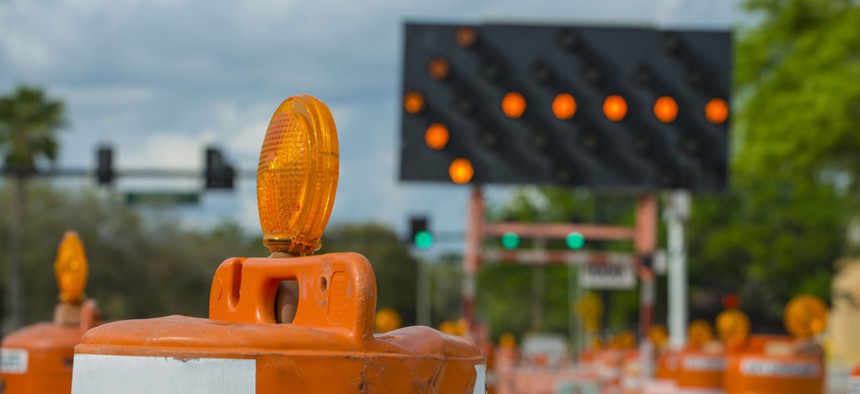Infrastructure Is Only Popular Without Concrete Details
Left-leaning economists, Democrats, and Republicans may agree with Donald Trump about the need to rebuild and repair, but how to pay for it is another issue.
The allure of focusing on American infrastructure during Trump’s first 100 days is self-evident: It’s an issue that has bipartisan support and, unlike choosing a Supreme Court nominee or reversing protections for undocumented immigrants or approving the Keystone XL pipeline, would be an ambitious legislative endeavor of his own creation. His potential $1 trillion infrastructure plan has incited passions, particularly among Democrats, who have long and vocally favored building projects to improve the economy. But even with similar goals, the parties remain split over what a palatable plan might look like and—for Democrats— whether they should work with Trump at all, particularly after they were obstructed on their own infrastructure plans by Republicans throughout President Obama’s presidency.
“Not all infrastructure plans are created equal,” Nell Abernathy, the vice president of research and policy for the liberal Roosevelt Institute, said in a call. “It may be bipartisan to say we want to do infrastructure, but we have to see what that actually means. I think this is a real test to see if Donald Trump and the Republicans are going to come forth with a plan that will actually boost the economy and create good jobs for Americans or is it going to be one similar to the one outlined during the campaign that would essentially line the pockets of corporations at the expense of long-term growth, working people, and the environment.”
Last week, the Roosevelt Institute released a paper that outlines a vision for an infrastructure plan that they say would create long-term economic growth and help the United States compete with the developed countries with superior infrastructure. But despite the bipartisan agreement about the need for infrastructure upgrades, the report includes several components that ring antithetical to Trump’s campaign talk, such as addressing climate change through green technology, tackling racial inequality through wider access to universal broadband, improving schools, and providing more efficient transportation in neglected communities. Abernathy says these points stand in contrast to Republican plans to build pipelines and drill, and the president-elect’s less-inclusive plan to build a wall on America’s southern border.
But beyond the potentially divergent approaches looms the question of how the expansion and improvements will be paid for. Abernathy’s colleague Eric Harris Bernstein pointed to an infrastructure proposal released by the Trump campaign in October that would rely on public-private partnerships, tax credits, and other private-sector incentives, which would likely require toll roads and bridges to entice investment. Bernstein characterized this approach as “a huge departure from this sort of populist message Trump ran on.”“They’re talking about having it all be financed by private investment, which is essentially the opposite of targeted [investments],” Abernathy adds. “It’ll go to the communities that have the potential to pay user fees and have the highest profit and ultimately reduce access and equity and basically turn our highway system into a bunch of toll roads.”
Richard Geddes, a professor of policy analysis and management at Cornell University and a visiting scholar at the conservative American Enterprise Institute, says that there is harmony across the political lines on “the notion that overall spending on infrastructure has been inadequate.” He suggests that the best way forward is to eschew the moonshot in favor of a more “surgical” approach to improving infrastructure quality. “The spending really has to be targeted on better, more efficient maintenance and operation of what we have, plus targeted expansions in the system,” he says. “We’re not going to rebuild the entire highway system, we’re going to add capacity—meaning a lane here, a lane there, expand facilities, particularly in urban areas as people move there.”
To pay for it, Geddes suggests there is some bipartisan consensus for public-private partnerships, but he also believes the private sector will be instrumental in funding the work ahead. One solution he encourages would include making tax-exempt municipal bonds, which citizens buy to help communities pay for local projects, available to the private companies to incentivize them to renovate infrastructure. Another possibility he offered would be to update the gas-tax system to collect revenue from drivers based on miles traveled rather than gallons purchased, which would generate more revenue from hybrid or electric cars.
According to reports last week, Trump's infrastructure plan may also include a national infrastructure bank, an idea purloined from the Democrats and the president-elect’s bested rival, Hillary Clinton, which would involve enticing corporations to repatriate their cash from overseas.
Of course, many Democrats and the Roosevelt Institute suggest that some infrastructure projects be financed by tax increases, be it on the wealthy or by closing of corporate loopholes or instating carbon taxes. These suggestions are anathema to Trump and many Republicans, some of whom have vowed not to raise taxes and not increase the debt. Meanwhile, on Tuesday, The Washington Post reported that House Democratic leader Nancy Pelosi said that she would oppose an infrastructure bill that banked heavily on tax breaks and privatization.
Despite these hurdles and the heavily partisan mood, the general spectrum of response to making infrastructure a priority has ranged from cautious optimism to outright optimism. Politicians, with a few exceptions, have not ruled out cooperation. At least not yet.



